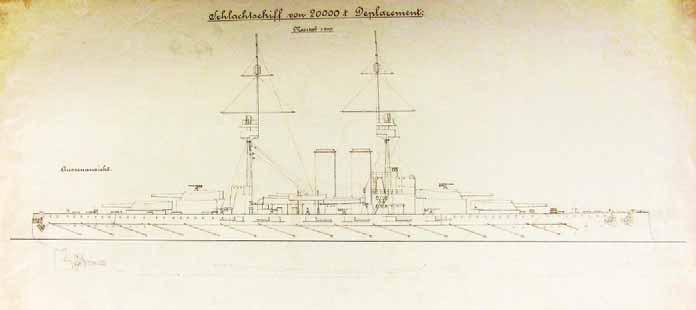The gunnery trials were conducted on 18 and 19 November and took place in the Fasana Channel. The trial of the main battery was conducted at a speed of 14-16 knots. The first salvo was fired at a range of 15,200 m then the range was gradually decreased to 10,000 m. The full salvos with the guns in each turret coupled together put extreme stress on the gun turrets and hull structure and resulted in the decalibration of the turret rangefinders. At a speed of 16 knots the fire control system failed to follow the rapidly changing range rate. There was a special problem in turret No III as the temperature rose to 45 degrees C because the ventilation duct was near a heat source.313 The cost of repairing the damages caused by the 30.5 cm guns was 1,460 Kronen. On her sisters the costs of the repairs after the gunnery trials were similar.314 The final trial of the gun turrets was conducted on 15 January 1916.315 When the Szent István was docked after the trials there were found much greater distortions in the underwater hull structure than on her sisters. A committee established that the Danubius had made some structural parts from lower quality material than the prescribed in the contract.316 The delivery record of 11 December listed the following issues: there were problems with some ventilators and with the refrigeration plants of the ammunition magazines, some spare parts were missing and the caulking of the teak deck was defective.317 On a summer maneuver in 1916 the whole electric system of the ship broke down, its manufacturer, the Ganz Villamossági Rt. repaired it under guarantee.318 The aft capstan also had to be replaced because when it was fitted sand and gravel got into its mechanism due to the negligence of shipyard workers.319 The total sum which the Navy paid to the Danubius for the hull and the machinery was 22,589,800 Kronen. In 1916, the Navy claimed a penalty of 475,000 Kronen from the Danubius for the delay. The Danubius asked the deduction of 398,466 Kronen as a compensation for the additional charges of the works in the Arsenal.320 The Navy counting the strikes and wartime circumstances finally reduced the penalty to 312,500 Kronen.321 Then the Danubius asked to cancel the penalty but the Navy refused it. Finally, the Navy and the shipyard agreed to postpone the negotiations on the penalty until the end of the war.322
Szent István was an unlucky ship: on her very first mission, during “Operation Korfu” on 10 June 1918, she was torpedoed and sunk by an Italian motor torpedo boat (MAS). In the “little war” on the Adriatic the heavy units of both the Austro-Hungarian and the Italian navies rested in their bases at Pola and respectively at Taranto. On 8 and 9 June Flottenkommandant Kontreadmiral Miklós Horthy sail to sea with all four dreadnoughts in two separate groups in an attempt to attack the Otranto Barrage and smash the inferior Allied forces. The second group was led by the Szent István followed by the Tegetthoff left Pola on the evening of 9 June. On 10 June, at 3:20 a.m. they accidentally met two Italian motor torpedo boats led by the famous Italian MAS commander capitano di corvetta Luigi Rizzo. The MAS-21 attacked the Tegetthoff without success. MAS-15 however succeeded in hitting the Szent István with two torpedoes. The torpedo protection system designed by Siegfried Popper failed to protect the ship. After three hours at 6:07 a.m. she capsized and at 6:12 a.m. sank with 89 hands. Opinions on the Szent István On 8 April 1916, the Navy asked the commanders of the battleships of the Tegetthoff class to write a report on their ships. While the other commanders wrote useful reports, Grassberger’s first version was rather a pamphlet against the shipyard so the Navy rejected it. Grassberger was notorious in the Navy for his manner and from his reports it is clearly visible that he disliked his new ship. Grassberger was the commander of the fleet’s flagship Viribus Unitis before his appointment to the Szent István and may he have felt this change of command as a reduction in prestige. His second version of the report was accepted but some of his proposals received criticism. Grassberger had previously criticized his new ship in his 3 December 1915 report on the list observed at large rudder angles during the full force trial. After presenting his theory on the causes of the list, he criticized the ammunition hoists of the 15 cm guns and questioned the watertightness of the manholes. Then he wrote a lengthy pamphlet on the (by his opinion) wrong construction of the waste pipes, backed with quotes from German and
— 91 —






























